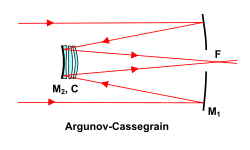Argunov–Cassegrain telescope

The Argunov–Cassegrain telescope is a catadioptric telescope design first introduced in 1972 by P. P. Argunov.[1] All optics are spherical, and the classical Cassegrain secondary mirror is replaced by a sub-aperture secondary corrector group consisting of three air-spaced elements, two lenses and a Mangin mirror (the element farthest from the primary mirror). Argunov systems only employ spherical surfaces and avoid the practical difficulties of making and testing aspheres. However, this benefit is marginal, as it is almost as difficult to make a true zone-free sphere of precise radius of curvature as it is to make an asphere of equivalent precision. Also since multiple surfaces are involved, creating a design with good aberration correction can be very complex.[2]
See also
References
- ↑ "Catadioptric Telescopes" Sky Gazette. Retrieved 2018-02-19.
- ↑ - Vladimir Sacek, telescope-optics.net, Notes on Amateur Telescope Optics, Catadioptric Telescopes, 10.2.1
Further reading
- P. P. Argunov, Izokhromaticheskie sistemy teleskopov so sfericheskoi optikoi [Isochromatic telescope designs with spherical optics], Astronomicheskij Vestnik, 6 (1), 52–61 (1972)
External links
- Astrokolonica page (archived)
- One-Meter Telescope in Kolonica Saddle
- Astronomical Observatory on Kolonica Saddle